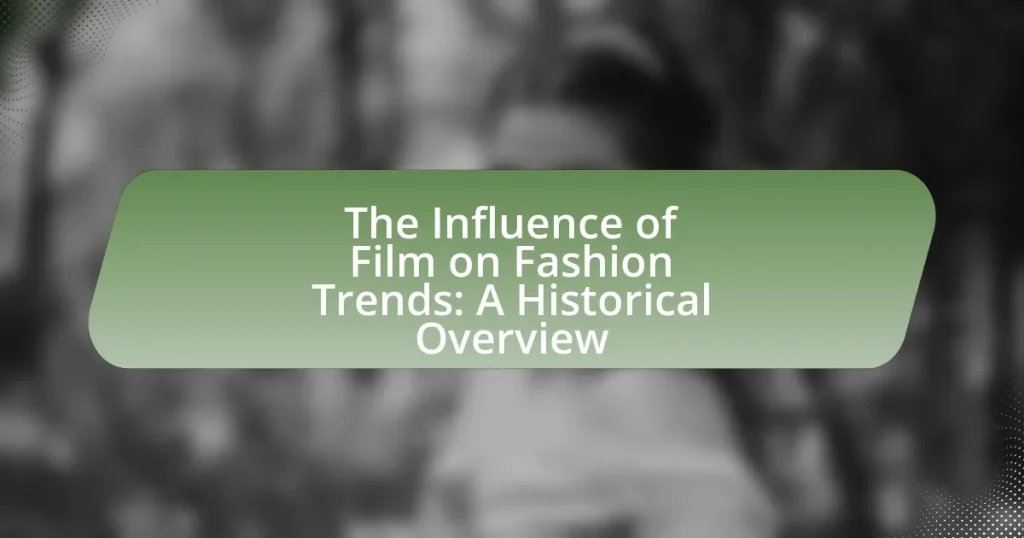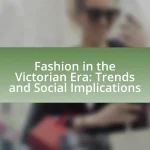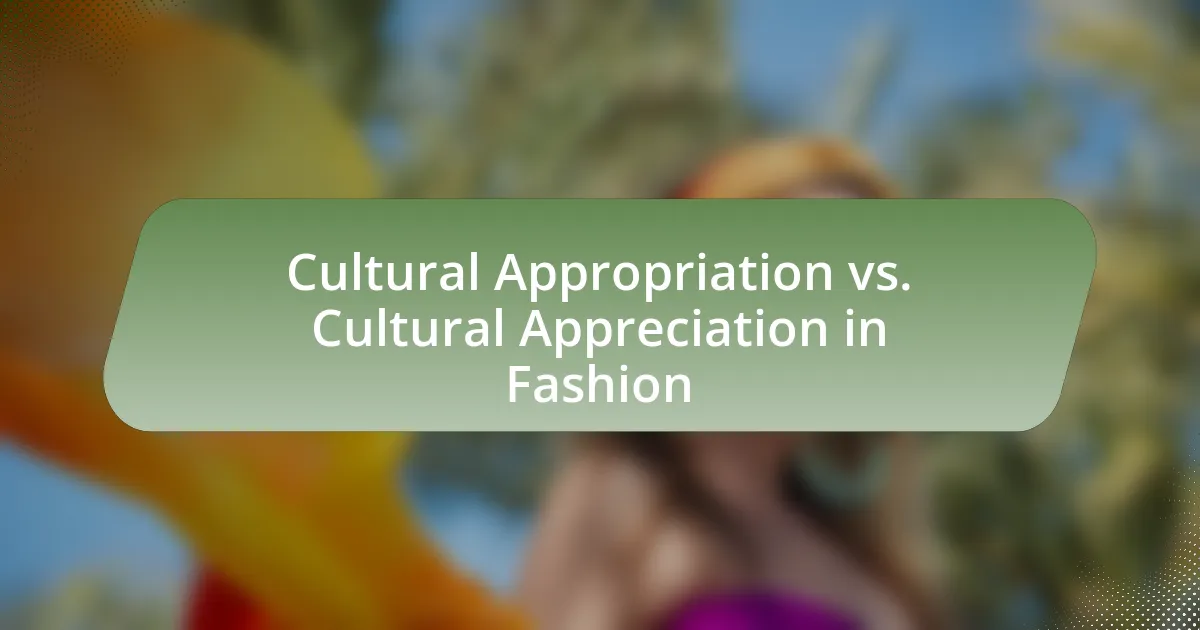The article examines the significant influence of film on fashion trends throughout history, highlighting how iconic films and their characters have shaped public perception and consumer behavior regarding style. It discusses key examples, such as Audrey Hepburn’s little black dress in “Breakfast at Tiffany’s” and the disco fashion popularized by “Saturday Night Fever,” illustrating the interplay between cinema and fashion. The article also explores the role of costume designers, the impact of cultural factors, and the evolution of styles across different eras, including the Golden Age of Hollywood and the rise of independent films. Additionally, it addresses contemporary films and social media’s role in shaping modern fashion trends, providing insights for fashion enthusiasts on incorporating film-inspired styles into their wardrobes.
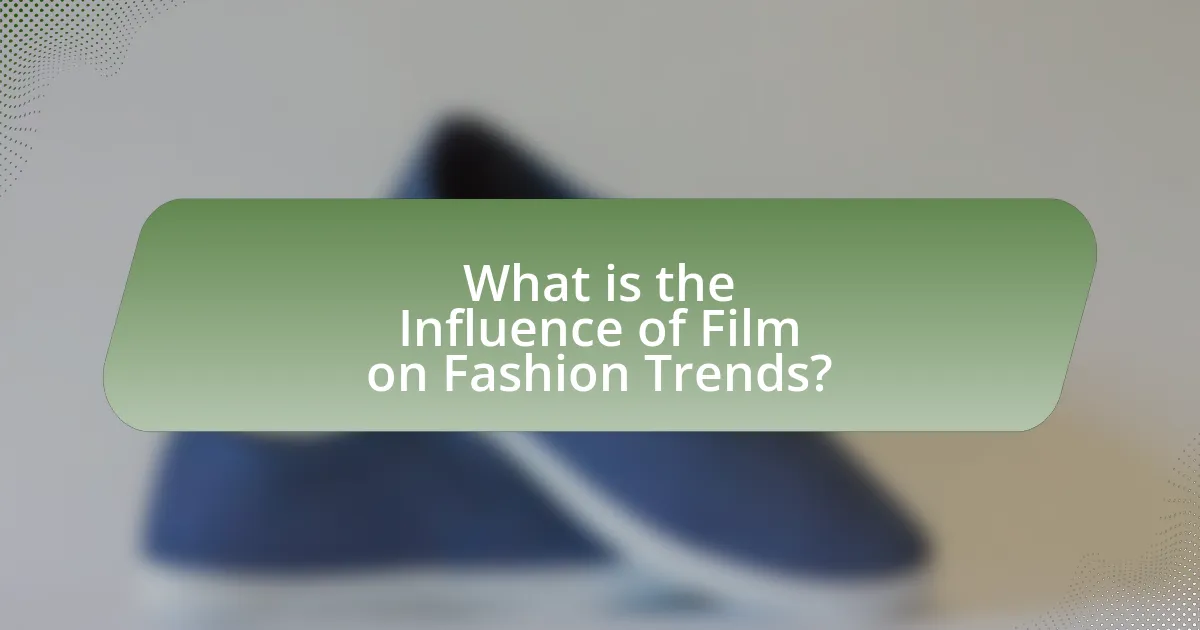
What is the Influence of Film on Fashion Trends?
Film significantly influences fashion trends by showcasing styles that become popularized through visual storytelling. Iconic films often introduce distinctive clothing and accessories that resonate with audiences, leading to widespread adoption in everyday fashion. For instance, Audrey Hepburn’s little black dress in “Breakfast at Tiffany’s” became a timeless fashion staple, illustrating how film can elevate specific styles to cultural phenomena. Additionally, the 1970s film “Saturday Night Fever” popularized disco fashion, influencing clothing choices and trends in nightlife. This demonstrates that films not only reflect societal fashion but also actively shape and redefine it, creating lasting impacts on consumer behavior and fashion industries.
How has film historically shaped fashion trends?
Film has historically shaped fashion trends by serving as a powerful medium that influences public perception and consumer behavior regarding style. Iconic films and their characters often introduce new clothing styles, which viewers then adopt in their everyday lives. For example, the release of “Breakfast at Tiffany’s” in 1961 popularized the little black dress, as worn by Audrey Hepburn, leading to a surge in its sales and adoption by women worldwide. Similarly, the 1980s film “Flashdance” sparked a trend for leg warmers and off-the-shoulder tops, demonstrating how cinematic portrayals can directly impact fashion choices. These examples illustrate that film not only reflects existing fashion trends but also actively creates and disseminates new styles, shaping societal norms around clothing.
What are some iconic films that have influenced fashion?
Iconic films that have influenced fashion include “Breakfast at Tiffany’s,” “The Great Gatsby,” and “Clueless.” “Breakfast at Tiffany’s,” released in 1961, showcased Audrey Hepburn’s elegant black dress designed by Hubert de Givenchy, which became a timeless symbol of sophistication. “The Great Gatsby,” particularly the 2013 adaptation, featured lavish costumes by Prada and Miuccia Prada, which revived 1920s fashion trends and inspired modern luxury styles. “Clueless,” released in 1995, popularized 1990s teen fashion, including the use of plaid skirts and knee-high socks, significantly impacting youth culture and fashion trends of that era. These films not only reflected their respective times but also set lasting trends that continue to influence fashion today.
How do costume designers impact fashion trends through film?
Costume designers significantly impact fashion trends through film by creating visually compelling wardrobes that resonate with audiences and influence consumer behavior. For instance, iconic films like “Breakfast at Tiffany’s,” featuring Audrey Hepburn’s little black dress designed by Hubert de Givenchy, sparked a global trend for similar elegant attire, demonstrating how film can shape public perception of style. Additionally, the work of costume designers like Edith Head and Milena Canonero has historically set trends that extend beyond the screen, as their designs often reflect and amplify contemporary fashion movements, leading to increased demand for similar styles in retail markets.
Why is the relationship between film and fashion significant?
The relationship between film and fashion is significant because films serve as a powerful medium for shaping and reflecting societal trends in clothing and style. This influence is evident in how iconic films and characters have popularized specific fashion trends, such as Audrey Hepburn’s little black dress in “Breakfast at Tiffany’s,” which became a timeless symbol of elegance. Additionally, the collaboration between filmmakers and fashion designers, such as the partnership between costume designer Edith Head and Paramount Pictures, has historically led to the creation of memorable fashion moments that resonate with audiences and impact consumer behavior. This interplay not only drives fashion trends but also reinforces cultural narratives, making the relationship between film and fashion a crucial aspect of both industries.
What cultural factors contribute to the influence of film on fashion?
Cultural factors such as societal norms, celebrity influence, and historical context significantly contribute to the influence of film on fashion. Societal norms dictate what is considered fashionable at any given time, and films often reflect or challenge these norms, thereby shaping public perception of style. For instance, the 1920s film “The Jazz Singer” popularized flapper fashion, which was a direct response to changing gender roles and societal expectations.
Celebrity influence is another critical factor; actors and actresses often become style icons, with their on-screen wardrobes inspiring trends. For example, Audrey Hepburn’s iconic little black dress in “Breakfast at Tiffany’s” has had a lasting impact on women’s fashion, symbolizing elegance and sophistication.
Additionally, historical context plays a role, as films set in specific eras can revive or reinterpret past styles, influencing contemporary fashion. The film “The Great Gatsby” (2013) reignited interest in 1920s fashion, showcasing the opulence of the Jazz Age and leading to a resurgence of flapper-inspired clothing in modern fashion.
These cultural factors collectively illustrate how film serves as a mirror and a catalyst for fashion trends, shaping and reflecting the zeitgeist of different eras.
How does film reflect societal changes in fashion?
Film reflects societal changes in fashion by visually representing the evolving cultural norms, values, and aesthetics of different eras. For instance, during the 1920s, films showcased flapper dresses that symbolized women’s liberation and changing gender roles, aligning with the broader societal shift towards modernity and independence. Additionally, the 1960s saw films like “Breakfast at Tiffany’s,” which popularized the little black dress, reflecting the era’s embrace of minimalism and sophistication. These cinematic portrayals not only influenced public fashion choices but also mirrored the social dynamics, such as the rise of youth culture and the impact of feminism, thereby serving as a barometer for fashion evolution in response to societal changes.
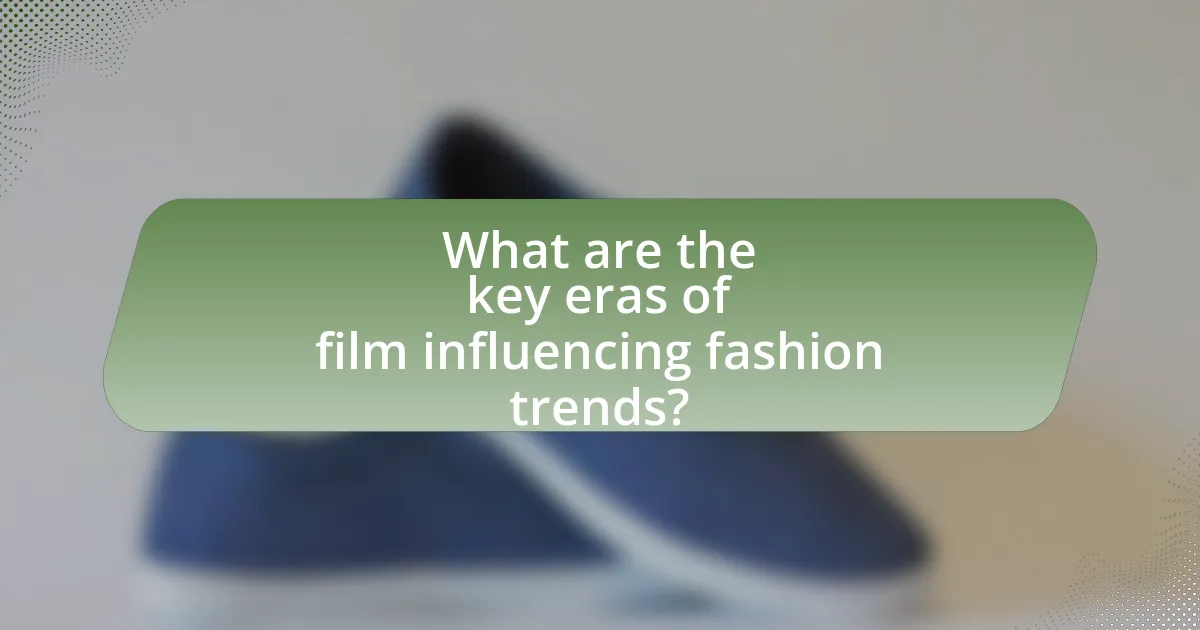
What are the key eras of film influencing fashion trends?
The key eras of film influencing fashion trends include the 1920s, 1950s, and 1980s. In the 1920s, silent films and the emergence of Hollywood stars popularized flapper dresses and cloche hats, reflecting the era’s social changes. The 1950s saw the rise of glamorous icons like Audrey Hepburn and Marilyn Monroe, leading to the popularity of tailored dresses and casual chic styles, which were showcased in films such as “Breakfast at Tiffany’s.” The 1980s introduced bold colors, oversized silhouettes, and power dressing, influenced by films like “Working Girl” and “Flashdance,” which mirrored the decade’s cultural shifts towards empowerment and individuality. Each of these eras significantly shaped public fashion choices, demonstrating the powerful relationship between cinema and style.
How did the Golden Age of Hollywood affect fashion?
The Golden Age of Hollywood significantly influenced fashion by popularizing glamorous styles and setting trends that shaped public perception of beauty and elegance. Iconic actresses like Audrey Hepburn and Marilyn Monroe became fashion symbols, leading to widespread emulation of their styles, which included tailored dresses, bold accessories, and sophisticated evening wear. This era also saw the rise of designer collaborations with studios, such as Edith Head, who created memorable costumes that transcended film and entered mainstream fashion. The impact was so profound that it established a direct link between cinema and fashion, with Hollywood dictating trends that were adopted globally, as evidenced by the surge in sales of similar styles in the 1950s and 1960s.
What styles emerged from the films of the 1950s?
The films of the 1950s gave rise to several distinct styles, notably the “New Look” in fashion, characterized by cinched waists and full skirts, popularized by icons like Audrey Hepburn and Grace Kelly. This era also saw the emergence of casual styles influenced by youth culture, including denim jeans and leather jackets, as showcased in films like “Rebel Without a Cause.” Additionally, the glamorous aesthetic of Hollywood led to an increase in formal wear, with tailored suits and elegant evening gowns becoming staples. These styles reflected the cultural shifts of the time, including post-war optimism and the rise of youth rebellion, solidifying the 1950s as a pivotal decade in fashion history.
Which actors became fashion icons during this era?
Audrey Hepburn and James Dean became fashion icons during this era. Audrey Hepburn, known for her roles in films like “Breakfast at Tiffany’s,” popularized the little black dress and elegant, minimalist style, influencing women’s fashion significantly. James Dean, recognized for his role in “Rebel Without a Cause,” epitomized coolness and youth culture, making denim jackets and casual wear iconic among men. Their distinctive styles not only defined their on-screen personas but also left a lasting impact on fashion trends that continue to resonate today.
What role did independent films play in fashion evolution?
Independent films significantly influenced fashion evolution by showcasing unique styles and subcultures that mainstream cinema often overlooked. These films often feature characters with distinct fashion choices that reflect their personalities and social contexts, thereby introducing audiences to alternative aesthetics. For example, films like “Clerks” and “The Blair Witch Project” highlighted everyday clothing and DIY fashion, which resonated with youth culture in the 1990s. This exposure led to the popularization of thrift store finds and casual wear, impacting broader fashion trends. Additionally, independent films often prioritize authenticity and individuality, encouraging designers to draw inspiration from these narratives, thus shaping contemporary fashion movements.
How did the rise of indie films change fashion trends?
The rise of indie films significantly changed fashion trends by promoting unique, individualistic styles that diverged from mainstream fashion. Indie films often feature characters with distinct, eclectic wardrobes that reflect personal identity and authenticity, influencing audiences to embrace similar styles. For example, films like “The Royal Tenenbaums” showcased vintage and quirky fashion choices, leading to a resurgence of thrift shopping and a preference for personalized fashion over mass-produced items. This shift is supported by the increasing popularity of fashion blogs and social media platforms, where indie film aesthetics inspire a broader audience to adopt unconventional styles, further solidifying the impact of indie cinema on contemporary fashion trends.
What are some examples of indie films that set fashion trends?
Some examples of indie films that set fashion trends include “The Virgin Suicides,” “Frances Ha,” and “Moonrise Kingdom.” “The Virgin Suicides,” directed by Sofia Coppola, popularized a nostalgic, ethereal aesthetic characterized by pastel colors and vintage clothing, influencing fashion in the early 2000s. “Frances Ha,” directed by Noah Baumbach, showcased a quirky, minimalist style that emphasized comfort and individuality, leading to a rise in casual, yet chic, urban wear. “Moonrise Kingdom,” also directed by Wes Anderson, featured a whimsical, retro-inspired wardrobe that sparked interest in vintage and preppy styles, particularly among younger audiences. These films not only reflected but also shaped contemporary fashion trends through their distinctive visual storytelling.
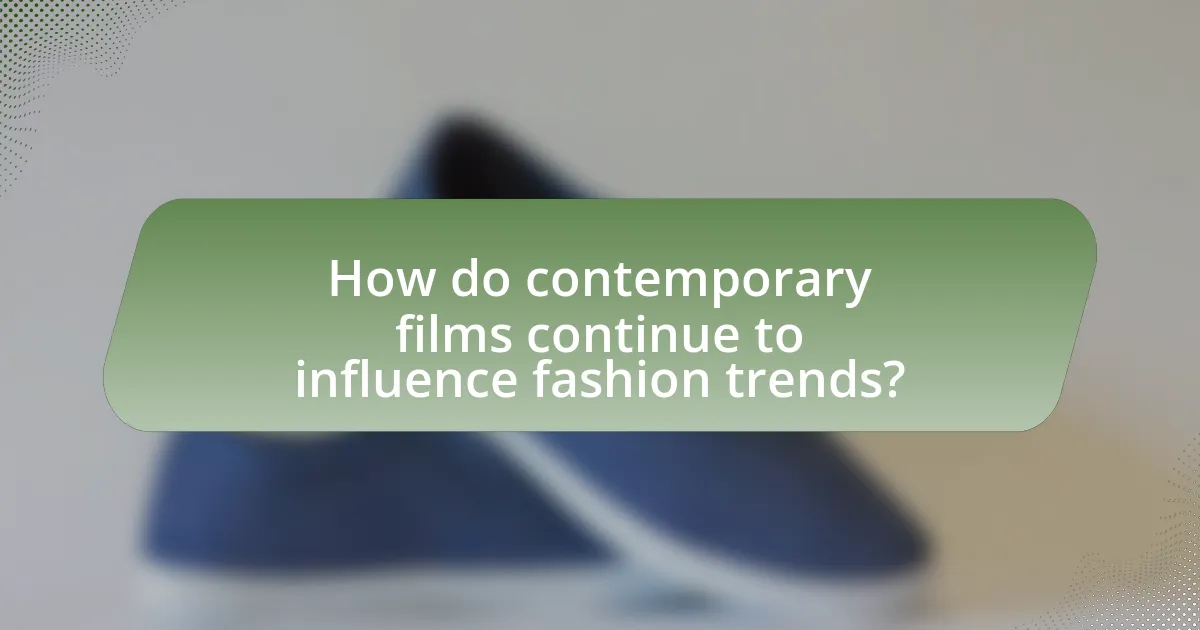
How do contemporary films continue to influence fashion trends?
Contemporary films continue to influence fashion trends by showcasing distinctive styles and aesthetics that resonate with audiences, leading to increased consumer demand for similar clothing. For instance, films like “The Devil Wears Prada” and “La La Land” have popularized specific fashion items, such as designer handbags and vintage-inspired outfits, which subsequently see a rise in sales in retail markets. Additionally, collaborations between fashion brands and film productions, such as the partnership between Gucci and the film “House of Gucci,” further solidify the connection between cinema and fashion, driving trends that reflect the cinematic narrative and character styles.
What current films are shaping modern fashion trends?
Current films shaping modern fashion trends include “Barbie,” “Dune,” and “The Devil Wears Prada.” “Barbie” has influenced vibrant color palettes and playful aesthetics, while “Dune” has popularized a futuristic, utilitarian style with its desert-inspired looks. “The Devil Wears Prada” continues to impact high fashion with its portrayal of luxury brands and sophisticated office wear. These films reflect and drive contemporary fashion choices, as evidenced by increased sales of similar styles and the rise of social media trends inspired by their visuals.
How do social media and film collaborations impact fashion today?
Social media and film collaborations significantly impact fashion today by amplifying trends and increasing visibility for designers. These collaborations create a synergy where films showcase fashion in a narrative context, while social media platforms enable rapid dissemination and engagement with these styles. For instance, the partnership between luxury brands and blockbuster films, such as Gucci’s collaboration with “House of Gucci,” not only elevates brand prestige but also influences consumer purchasing behavior, as seen in a 2021 study by the Fashion Institute of Technology, which reported a 30% increase in searches for Gucci items following the film’s release. This dynamic interaction between visual storytelling in film and the immediacy of social media allows fashion trends to evolve quickly, making them more accessible and relatable to a broader audience.
What trends have emerged from recent blockbuster films?
Recent blockbuster films have increasingly showcased diverse representation and strong female leads, reflecting broader societal changes. This trend is evident in films like “Black Panther,” which highlighted African culture and featured a predominantly Black cast, and “Wonder Woman,” which emphasized female empowerment. Additionally, the rise of streaming platforms has led to a surge in content that prioritizes inclusivity, with films such as “Crazy Rich Asians” breaking box office records while centering Asian narratives. These trends indicate a shift towards more varied storytelling that resonates with global audiences, ultimately influencing fashion by promoting styles that reflect these diverse cultures and identities.
How can fashion designers leverage film for inspiration?
Fashion designers can leverage film for inspiration by analyzing the visual storytelling, character aesthetics, and cultural contexts presented in movies. Films often showcase unique styles and trends that reflect societal values and artistic movements, providing designers with a rich source of ideas. For instance, the 1954 film “Sabrina” influenced the popularity of the little black dress, demonstrating how cinematic fashion can shape public perception and consumer behavior. Additionally, films like “The Great Gatsby” have revived vintage styles, illustrating how designers can draw from historical references depicted in cinema to create contemporary collections.
What strategies can designers use to incorporate film aesthetics into their collections?
Designers can incorporate film aesthetics into their collections by analyzing iconic film styles and translating them into wearable fashion. This involves studying costume design, color palettes, and character silhouettes from influential films, such as the use of bold colors and structured lines in “The Devil Wears Prada,” which reflects high fashion. Additionally, designers can collaborate with filmmakers to create collections inspired by upcoming films, ensuring that the designs resonate with cinematic themes and narratives. Historical examples include the impact of Audrey Hepburn’s wardrobe in “Breakfast at Tiffany’s,” which led to a surge in demand for similar styles. By leveraging these strategies, designers can effectively merge cinematic elements with contemporary fashion.
How can collaborations between filmmakers and fashion designers enhance trends?
Collaborations between filmmakers and fashion designers enhance trends by merging visual storytelling with innovative fashion, creating a powerful cultural impact. This synergy allows filmmakers to showcase unique styles and aesthetics that resonate with audiences, while fashion designers gain exposure and credibility through association with cinematic narratives. For instance, the partnership between director Baz Luhrmann and fashion designer Miuccia Prada in “The Great Gatsby” not only revitalized 1920s fashion but also influenced contemporary trends, leading to a resurgence of Art Deco styles in modern clothing. Such collaborations often set new standards in fashion, as seen in the iconic costumes of films like “Black Panther,” which sparked global interest in African-inspired designs.
What practical tips can fashion enthusiasts learn from film influences?
Fashion enthusiasts can learn to curate their wardrobes by analyzing iconic film characters and their signature styles. For instance, the character Holly Golightly from “Breakfast at Tiffany’s” popularized the little black dress, demonstrating the impact of a single outfit on fashion trends. Additionally, films like “The Devil Wears Prada” showcase the importance of high fashion and designer labels, encouraging enthusiasts to invest in key pieces that elevate their style. By observing the color palettes, silhouettes, and accessories used in films, fashion enthusiasts can draw inspiration to create cohesive and stylish outfits that reflect their personal aesthetics.
How can individuals incorporate film-inspired fashion into their wardrobes?
Individuals can incorporate film-inspired fashion into their wardrobes by selecting key pieces that reflect iconic styles from their favorite movies. For example, they can choose vintage dresses reminiscent of classic films like “Breakfast at Tiffany’s” or tailored suits inspired by characters in “Mad Men.” This approach allows individuals to blend cinematic aesthetics with personal style, making fashion choices that resonate with their identity. Historical context supports this practice, as film has long influenced fashion trends; for instance, the 1950s saw a surge in popularity for styles showcased in Hollywood films, leading to widespread adoption of similar looks in everyday life.
What are the best practices for staying updated on film-related fashion trends?
To stay updated on film-related fashion trends, regularly follow fashion-focused publications, websites, and social media accounts that cover film events and celebrity styles. Sources like Vogue, The Hollywood Reporter, and Entertainment Weekly frequently analyze and report on fashion trends emerging from films. Additionally, attending film festivals and award shows, such as the Oscars or Cannes, provides firsthand insight into the latest styles showcased by actors and designers. Engaging with fashion influencers and stylists on platforms like Instagram and TikTok can also offer real-time updates and interpretations of film-inspired fashion.
